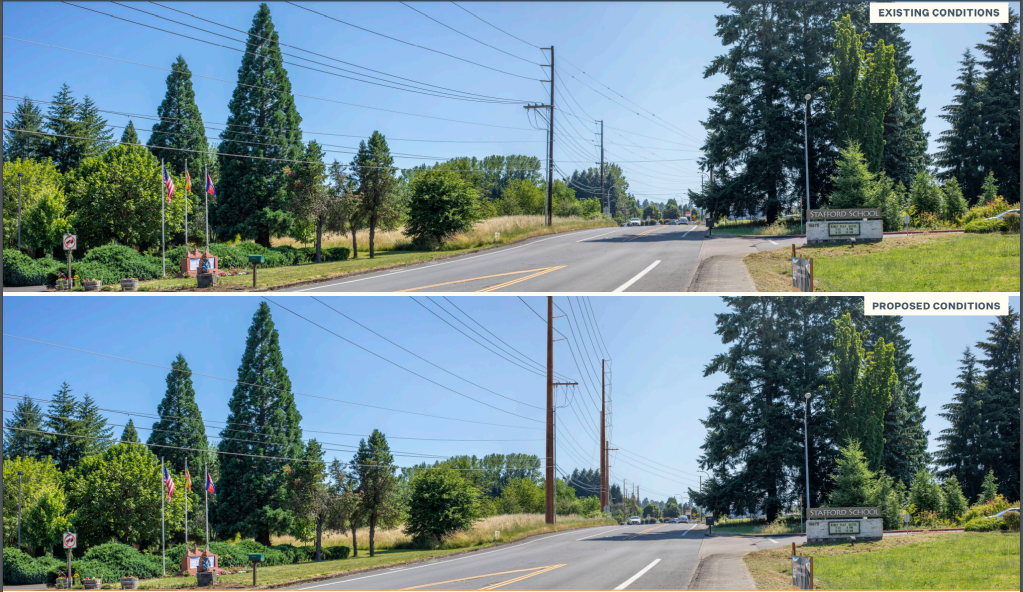Portland General Electric faces continued legal challenges, resident pushback for Tonquin Project
Published 1:51 pm Friday, June 13, 2025

- A simulation shows what one section of Stafford Road could look like after completion of upgrades to power poles and transmission lines related to the Tonquin Project. (Submitted by Portland General Electric)
Uncertainty continues to loom over Portland General Electric’s controversial project to upgrade transmission lines near Wilsonville.
The electricity company was granted a certificate from the Oregon Public Utility Commission allowing it to condemn property for a project upgrading power lines and poles along Stafford Road, but was recently denied land use approval for the project by Clackamas County. Despite the denial, residents who have waged a two-year fight against the project fear PGE could condemn the property anyway.
What does the project involve?
PGE has faced a complex web of legal challenges to implementing the project along Stafford Road, which would upgrade approximately 7.4 miles of transmission lines and power poles between the Rosemont and Wilsonville substations. It is one leg of the Tonquin Project, which involves building a new substation and upgrading 11 miles of transmission lines across Tualatin, Sherwood, the Stafford area, Wilsonville and unincorporated Clackamas County.
Trending
In past interviews, PGE spokesperson Andrea Platt has said the project will help modernize the power grid and allow redundancy — alternative routes power can travel along if one is blocked — to accommodate future growth.
The document from Clackamas County denying a land use permit to PGE shows 137 power poles are planned for upgrades as part of the Rosemont-Wilsonville leg, and 124 of them are within the public right of way. Seven are on tax lots owned by PGE and six are on private property. Easements are required at 25 properties for the power lines or vegetation maintenance.
Existing power poles are between 20 and 75 feet tall, with the majority standing 30-40 feet tall or 65-70 feet tall. The document shows new poles will range between 30-130 feet tall, with around 60 poles over 90 feet.
Residents have long expressed concerns about the project, including potential fire risks, decrease in property values, negative impacts to the area’s rural character and loss of trees.
Obtaining the certificate allowing condemnation
In a March 28 ruling, PGE was granted a Certificate of Public Necessity from the Oregon Public Utility Commission — nearly one year after applying. According to the document, the utilities commission found that the project was justified due to anticipated increases in power demand, including from a new water treatment plant being constructed by the Willamette Water Supply System Commission.
“While we acknowledge that some property owners along the Rosemont-Wilsonville route will bear negative visual impacts and temporary construction impacts, and that taller towers and a wider corridor may impact the area’s rural character, we do not find that these impacts outweigh the broader regional and societal need for reliable power,” the commission wrote in the ruling, adding that it did not believe safety would be compromised for the residents or that better alternatives existed.
Trending
“We find that the proposed line will be constructed, operated and maintained safely according to best practices that are subject to ongoing improvement through our review of wildfire mitigation plans,” the commission wrote.
When initially applying for the certificate, PGE had obtained 78% of the easements required to upgrade poles, but anticipated that it may need to condemn some property to move forward. Representatives of Save Stafford Road, an organization of Stafford residents fighting against the project, said at the time that a dozen property owners refused to give their signatures required for a land use permit.
Kelly Bartholomew, a Stafford resident who is a part of Save Stafford Road but participated in the utility commission’s process as an individual, said property owners are worried PGE could use the certificate to condemn property in preparation for the project, but never receive the required permits.
“What if (PGE doesn’t) get the land use permit, and the owner wants their property back? Are they then required to pay a lawyer … to get their easement back?” Bartholomew said, adding that she believes granting the certificate to allow condemnation before obtaining a land use approval “completely puts the cart before the horse.”
Ed Wagner, another member of Save Stafford Road, added that if PGE does not acquire the permit residents may need to hire a lawyer and pay legal fees to negotiate compensation for land condemned for a project that can’t move forward.
However, a scenario in which PGE condemns property but is not allowed to move forward with the project would mean it could spend considerable money for no practical use.
In a legal briefing submitted in February prior to the utility commission’s hearing regarding the certificate, PGE wrote that while it may seek immediate occupancy of property but “whether that is granted and for what purposes will be determined by a court in the condemnation proceeding,” and “appropriate compensation” would be determined in later court proceedings.
Based on that and a belief that her due process with the utility commission was violated through “a number of procedural inconsistencies” Bartholomew said she is appealing the decision granting the certificate to the Oregon Court of Appeals.
In an email, Platt said PGE acknowledges it must acquire the land use permit to move forward with “the urgently needed” segment of the project. PGE did not directly answer the question of whether it would condemn property before getting the permits. Platt wrote in an email that “PGE is working to resolve all land use matters in order to move forward with this urgently needed project.”
Struggle to receive land use approval
On March 26, two days before PGE was granted the certificate allowing condemnation proceedings, Clackamas County denied the company a land use permit to move forward with the project. The rejection followed a decision by the Land Use Board of Appeals in January ordering the county to consider PGE’s application after the county voided the company’s land use permit last fall for failing to obtain approval from the affected property owners.
Records show PGE appealed the rejection to Clackamas County on April 2, but was also granted a request to push the appeal hearing back to August. Platt said the electricity company requested the delay so it could focus on a different avenue for land use approval.
”The land use process can be complicated, and the information needed to ensure PGE addresses the feedback received through county and community processes can take time,” Platt wrote in an email. “In an effort to avoid over-burdening the county, and to be judicious with costs, our efforts are focused on working through the conditional use process and holding on the appeal for now, in hopes we can expeditiously resolve the land use matters.”
Because some of the existing power poles do not align with county code, they are considered a “nonconforming use.” PGE’s rejected application centered around giving the company approval to make changes to the poles, thus altering the existing nonconforming use.
In its document denying the permit, the county wrote that PGE’s plans to upgrade power poles and lines would cause more negative impacts to the neighborhood than the existing power poles through the removal of 256 trees, creation of visual impacts to the scenic corridor and devaluation of property. It wrote that “these impacts cannot be mitigated by conditions of approval.”
The rejection document addressed each of the items adversely affecting neighborhoods, noting the county’s concerns with removing trees that act as a buffer between homes and major roadways, visual impacts of the larger power poles and additional powerlines along the road with designation as a scenic route, and the fact that that PGE acknowledged that property values would fall due to the project.
“The degree of property value loss due to the presence of transmission lines is not definitively identified in either the application or the information provided by the opponents,” the document states. “However, even the potential 2-percent decrease in property values estimated by the applicant’s own consultant constitutes a greater adverse impact to the neighborhood.”
Additionally, one of the county’s requirements states the changes cannot expand upon the existing nonconforming use — a condition the county wrote PGE did not meet. The county stated it was “unable to verify” if the upgrades would cause the power lines or poles to expand significantly beyond where they exist currently.







